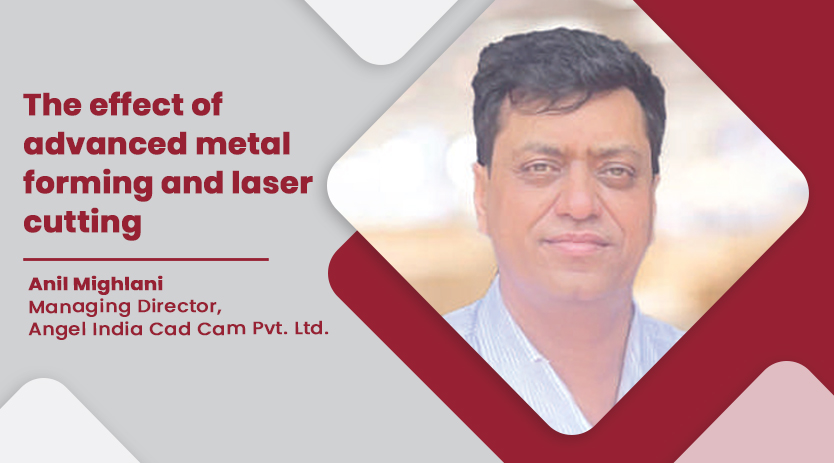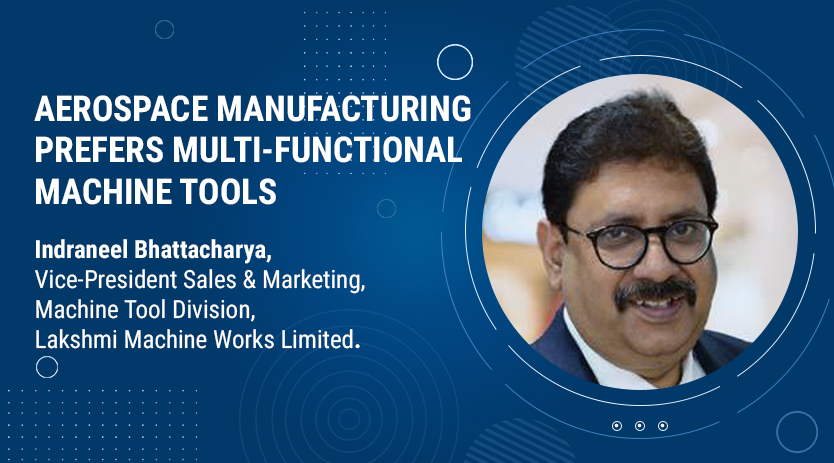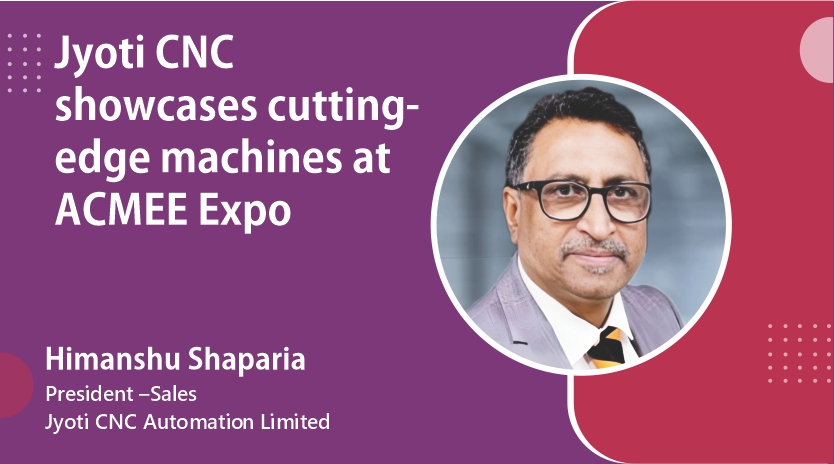Production efficiency and monitoring: Sustaining the criticality of manufacturing
June 18, 2019 12:53 pm
With a good portfolio of foolproof products for Industry 4.0, called ANCA Management Suite REDAX, Kishore AP, National Sales & Marketing Manager- India, ANCA CNC Machines, in an interaction with Aultrin Vijay of OEM Update, discusses why some MSMEs are still lacking in their adoption of Industry 4.0 and why this matters.
In spite of Digital India vision, only forward-looking industries are investing in technologies, why do you think the MSME sector is still lagging behind in accepting the change?
The first challenge is making people aware of the fundamental benefits of investing in technology that will enable a ‘smart factory.’ Secondly, India is still lagging in the cases of standard operating processes or normal business process, particularly when it comes to systematic processing.
One of the major challenges for the MSMEs or small-scale industries is the challenge of integrating Digital India or digitisation into their processes. Digitalisation is a standard operating procedure that needs to be understood and followed if the benefits of a ‘smart factory’ – such as efficiencies, cost reduction, scalability are able to be realised.
Change will not happen in one radical moment; at ANCA we understand this intuitively. For almost 50 years we’ve been on the journey to help our customers move towards a smart factory solution. Every world-first technology we’ve introduced, from 3D simulation software to Laser Plus, our in-process measurement system, to RoboTeach, which makes robotic loaders accessible and easy to program, has been iterative rather than completely revolutionary.
Should India look at Industry 4.0 as an additive advantage for automation and a lucrative investment destination by other countries?
Yes, the rise of using technology is pervasive across all regions and markets, including the cutting tools industry. As more manufacturers turn to leaner processes and ‘smart factories’ that use Industry 4.0 technology they are reaping the benefits of increased productivity, improved precision and more responsive delivery times for customers.
Investing in the technology to build a Smart Factory means Indian businesses can be just as competitive as those manufacturers in Switzerland, Germany and Japan as the quality of the product and manufacturing processes are just as sophisticated.
Most of our Indian customers have implemented Industry 4.0 to an extent using our technology that can connect grinding machines. For example, ANCA’s Management Suite REDAX (Remote Data Analytics), is a virtual machine monitoring technology. This enables customers to monitor the efficiency and productivity of their machines from their office or anywhere in the world remotely. The software suite allows customers to have a better control on their grinding files, wheel packs, wheel inventory.
Tell us a bit more about the Management Suite REDAX.
We launched REDAX two years back. Since then, we have been receiving good support and feedback from all over India and the world. With REDAX, we’ve enjoyed a good success record where customers are running ‘lights out’ manufacturing. The software and in process measurement accessories, such as our Laser Plus means productivity can be easily controlled and improved, processes are monitored and corrective action is taken automatically during the machining. It’s a virtual machine technology that is reaping huge benefits.
When planning new batches, the operational performance of machines and live production data can be considered to make informed operational improvements. Businesses who have the systems in place are a step ahead of their competitors.
How do you deal with technology disruptions at the operational level?
Smart factory technologies are becoming more common worldwide, but in India we are still at the beginning. To get up to speed, companies need to train or find staff who understand both the concept and how to practically install this step by step, into their facilities.
Another important factor is that without a company instilling sound lean principals so that the whole process of ordering, manufacturing, invoicing, receiving, servicing, and disposing of a product are understood – implementing new technology will not reap the same benefits. Being lean is being committed to a process of constant improvement. Companies can start by analysing down times, audit machines and see how often they’re adding or not adding value. Look to your entire supply chain and see where blockages are. Technology, especially management suite software can help give you this overview.
What are the areas to be considered for making the transition to smart factory?
While much of the core technology of smart factories is in in use by many cutting tool manufacturers to some degree, for most manufacturers the shift to smart factories will happen pragmatically through a series of phases, assisting as it does with capital expenditure, experimentation and staff training. This doesn’t mean companies should take a ‘wait and see’ approach though. Delaying investment could increase the size of the technology gap and could result in lagging behind more active competitors from day one.
If you want to have a Smart Factory, you need smart operating procedures. From getting orders, to organising available resources, to the design stage or the order stage and documenting and standardising. The transition ends with the delivery and customer feedbacks
What is ANCA’s contribution to the aerospace industry of India?
As the Indian government of India has taken several initiatives to promote electric vehicles, we are aware that there will be a significant drop in the demand for machining activities in the automotive industry. At the same time, there is great opportunity for the aerospace industry and while it is a complex sector, companies are investing in technology to ensure they can service these industries. Backed by technologies from ANCA, our customer Aayudh Tools is well-equipped to serve the challenging aerospace industry. With the help of ANCA’s MX5 and TX7, Aayudh Tools have increased productivity by about 30 per cent and looking to enter new and challenging sectors like aerospace.
Another customer, are targeting the aerospace industry with diamond coated cutting tools. They know that a diamond coated tool offers longevity, repeatability and predictability. With the materials being used to build aeroplanes today, the manufacturing process uses a significant amount of carbon fibre, and you need diamond coated tools to cut it.
Other than the cutting tool industry, ANCA has a success market in the aerospace turbine blade application industry. Turbine blade require high energy output application such as aerospace and power generation. ANCA provides the capability to grind and complete multiple manufacturing operation for a blade root form section in one setup.
How do you view your industry’s roadmap for the future?
If you talk about the Indian machining industry, the last three years have been fantastic. We are expecting the government will continue to invest in infrastructure, aerospace, power generation, automotive industries; these are the areas which that will experience the most growth, especially the infrastructure industry. And to get the most of these opportunities companies need to learn Industry 4.0.
The factory of the future will not arrive fully formed in one ‘big bang’ moment. While there will be big leaps along the way, it will more often be a gradual process. But while much of the core technology is already in place, we have identified some interesting developments on the horizon which hold great promise for tool manufacturers. New technology like self-driving vehicles. With many automotive manufacturers experimenting with for self-driving vehicles the introduction of SDVs as an extension of factory automation across the supply chain is not far off.
While many future innovations will arrive organically into our factories, others will need to be proactively pursued. The addition of new workers who are technologists and specialists in this space will be essential to maintain a competitive edge, but current workers should also expect more training and upskilling in years to come. As the trend to lean manufacturing grows, greater integration and ‘sharing’ of skill sets across the factory floor will become a more common feature in pursuit of a more agile operation.
Standardising businesses process in a smarter way of operating; it reduces mistakes and increases productivity, accuracy and quality
Kishore AP, National Sales & Marketing Manager- India, ANCA CNC Machines
Cookie Consent
We use cookies to personalize your experience. By continuing to visit this website you agree to our Terms & Conditions, Privacy Policy and Cookie Policy.

















 English
English Hindi
Hindi